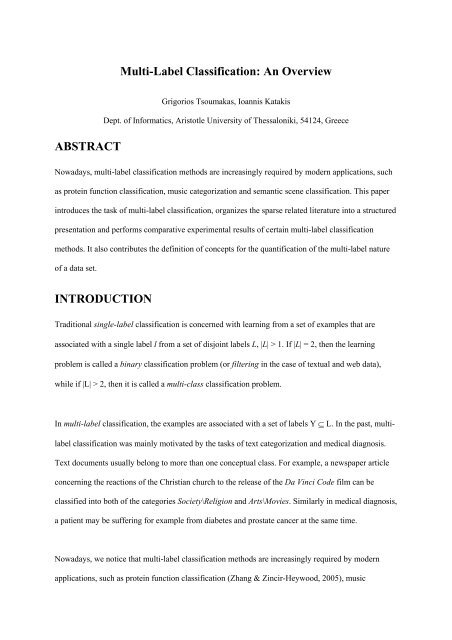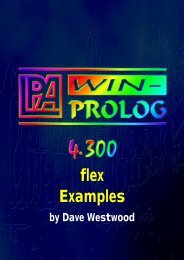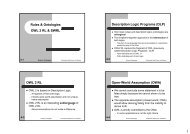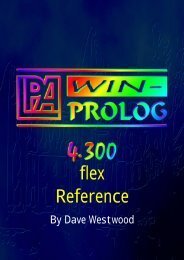A Review of Multi-Label Classification Methods - LPIS
A Review of Multi-Label Classification Methods - LPIS
A Review of Multi-Label Classification Methods - LPIS
Create successful ePaper yourself
Turn your PDF publications into a flip-book with our unique Google optimized e-Paper software.
categorization (Li & Ogihara, 2003) and semantic scene classification (Boutell et al., 2004). Insemantic scene classification, a photograph can belong to more than one conceptual class, such assunsets and beaches at the same time. Similarly, in music categorization a song may belong to morethan one genre. For example, several hit songs <strong>of</strong> the popular rock band Scorpions can becharacterized as both rock and ballad.This paper aims to serve as a starting point and reference for researchers interested in multi-labelclassification. The main contributions are: a) a structured presentation <strong>of</strong> the sparse literature onmulti-label classification methods with comments on their relative strengths and weaknesses andwhen possible the abstraction <strong>of</strong> specific methods to more general and thus more useful schemata, b)the introduction <strong>of</strong> an undocumented multi-label method, c) the definition <strong>of</strong> a concept for thequantification <strong>of</strong> the multi-label nature <strong>of</strong> a data set, d) preliminary comparative experimental resultsabout the performance <strong>of</strong> certain multi-label methods.The rest <strong>of</strong> the paper is organized as follows. The next section discusses tasks that are related to multilabelclassification. Subsequently follows an organized presentation <strong>of</strong> multi-label classificationmethods. The next section introduces the concept <strong>of</strong> label density and presents the metrics that havebeen proposed in the past for the evaluation <strong>of</strong> multi-label classifiers. The following section presentsthe comparative experiments and discusses the results, while the concluding section summarizes thiswork and points to future research directions.RELATED TASKSA task that also belongs to the general family <strong>of</strong> supervised learning and is very relevant to multi-labelclassification is that <strong>of</strong> ranking. In ranking the task is to order a set <strong>of</strong> labels L, so that the topmostlabels are more related with the new instance. There exist a number <strong>of</strong> multi-label classificationmethods that learn a ranking function from multi-label data. However, a ranking <strong>of</strong> labels requirespost-processing in order to give a set <strong>of</strong> labels, which is the proper output <strong>of</strong> a multi-label classifier.
<strong>of</strong> learning algorithms. We call algorithm adaptation methods, those methods that extend specificlearning algorithms in order to handle multi-label data directly.Problem transformation methodsTo exemplify these methods we will use the data set <strong>of</strong> Table 1. It consists <strong>of</strong> four examples(documents in this case) that belong to one or more <strong>of</strong> four classes: Sports, Religion, Science, andPolitics.Table 1: Example <strong>of</strong> a multi-label data setEx. Sports Religion Science Politics1 X X2 X X3 X4 X XThere exist two straightforward problem transformation methods that force the learning problem intotraditional single-label classification (Boutell et al., 2004). The first one (dubbed PT1) subjectively orrandomly selects one <strong>of</strong> the multiple labels <strong>of</strong> each multi-label instance and discards the rest, whilethe second one (dubbed PT2) simply discards every multi-label instance from the multi-label data set.Table 2 and Table 3 show the transformed data set using methods PT1 and PT2 respectively. Thesetwo problem transformation methods discard a lot <strong>of</strong> the information content <strong>of</strong> the original multilabeldata set and are therefore not considered further in this work.Table 2: Transformed data set using PT1Ex. Sports Religion Science Politics1 X2 X3 X4 XTable 3: Transformed data set using PT2Ex. Sports Religion Science Politics3 X
The third problem transformation method that we will mention (dubbed PT3), considers each differentset <strong>of</strong> labels that exist in the multi-label data set as a single label. It so learns one single-labelclassifier H: X → P(L) , where P(L) is the power set <strong>of</strong> L. Table 4 shows the result <strong>of</strong> transforming thedata set <strong>of</strong> Table 1 using this method. One <strong>of</strong> the negative aspects <strong>of</strong> PT3 is that it may lead to datasets with a large number <strong>of</strong> classes and few examples per class. PT3 has been used in the past in(Boutell et al., 2004; Diplaris et al., 2005).Table 4: Transformed data set using PT3Ex. Sports (Sports ∧ Politics) (Science ∧ Politics) (Science ∧ Religion)1 X2 X3 X4 XThe most common problem transformation method (dubbed PT4) learns |L| binary classifiers H l : X →{l, ¬l} , one for each different label l in L. It transforms the original data set into |L| data sets D l thatcontain all examples <strong>of</strong> the original data set, labelled as l if the labels <strong>of</strong> the original examplecontained l and as ¬l otherwise. It is the same solution used in order to deal with a single-label multiclassproblem using a binary classifier.For the classification <strong>of</strong> a new instance x this method outputs as a set <strong>of</strong> labels the union <strong>of</strong> the labelsthat are output by the |L| classifiers:H( x) = { l}:H ( x) l=PT 4Ull∈LFigure 1 shows the four data sets that are constructed by PT4 when applied to the data set <strong>of</strong> Table 1.PT4 has been used in the past in (Boutell et al., 2004; Goncalves & Quaresma, 2003; Lauser & Hotho,2003; Li & Ogihara, 2003).
Algorithm adaptation methodsClare and King (2001) adapted the C4.5 algorithm for multi-label data. They modified the formula <strong>of</strong>entropy calculation as follows:entropyN( S ) = −∑( p( ci) log p( ci) + q( ci) log q( ci))i=1where p(c i ) = relative frequency <strong>of</strong> class c i and q(c i ) = 1−p(c i ). They also allowed multiple labels inthe leaves <strong>of</strong> the tree.Adaboost.MH and Adaboost.MR (Schapire & Singer, 2000) are two extensions <strong>of</strong> AdaBoost (Freund& Schapire, 1997) for multi-label classification. They both apply AdaBoost on weak classifiers <strong>of</strong> theform H:X ×L → R. In AdaBoost.MH if the sign <strong>of</strong> the output <strong>of</strong> the weak classifiers is positive for anew example x and a label l then we consider that this example can be labelled with l, while if it'snegative then this example is not labelled with l. In AdaBoost.MR the output <strong>of</strong> the weak classifiers isconsidered for ranking each <strong>of</strong> the labels in L.Although these two algorithms are adaptations <strong>of</strong> a specific learning approach, we notice that at theircore, they actually use a problem transformation (dubbed PT6): Each example (x, Y) is decomposedinto |L| examples (x, l, Y[l]), for all l ∈ L, where Y[l] = 1 if l ∈ Y, and [l] = −1 otherwise. Table 6shows the result <strong>of</strong> transforming the data set <strong>of</strong> Table 1 using this method.ML-kNN (Zhang & Zhou, 2005) is an adaptation <strong>of</strong> the kNN lazy learning algorithm for multi-labeldata. Actually this method follows the paradigm <strong>of</strong> PT4. In essence, ML-kNN uses the kNN algorithmindependently for each label l: It finds the k nearest examples to the test instance and considers thosethat are labelled at least with l as positive and the rest as negative. What mainly differentiates thismethod from the application <strong>of</strong> the original kNN algorithm to the transformed problem using PT4 isthe use <strong>of</strong> prior probabilities. ML-kNN has also the capability <strong>of</strong> producing a ranking <strong>of</strong> the labels asan output.
Table 6: Transformed data set using PT6Ex. l Y[l]1 Sports 11 Religion -11 Science -11 Politics 12 Sports -12 Religion -12 Science 12 Politics 13 Sports 13 Religion -13 Science -13 Politics -14 Sports -14 Religion 14 Science 14 Politics -1Luo and Zincir-Heywood (2005) present two systems for multi-label document classification, whichare also based on the kNN classifier. The main contribution <strong>of</strong> their work is on the pre-processingstage for the effective representation <strong>of</strong> documents. For the classification <strong>of</strong> a new instance, thesystems initially find the k nearest examples. Then for every appearance <strong>of</strong> each label in each <strong>of</strong> theseexamples, they increase a corresponding counter for that label. Finally they output the N labels withthe largest counts. N is chosen based on the number <strong>of</strong> labels <strong>of</strong> the instance. This is an inappropriatestrategy for real-world use, where the number <strong>of</strong> labels <strong>of</strong> a new instance is unknown.McCallum (1999) defines a probabilistic generative model according to which, each label generatesdifferent words. Based on this model a multi-label document is produced by a mixture <strong>of</strong> the worddistributions <strong>of</strong> its labels. The parameters <strong>of</strong> the model are learned by maximum a posterioriestimation from labelled training documents, using Expectation Maximization to calculate whichlabels were both the mixture weights and the word distributions for each label. Given a new documentthe label set that is most likely is selected with Bayes rule. This approach for the classification <strong>of</strong> a
held out validation set. Note here that the second approach for margin improvement is actually SVMindependent. Therefore, it could also be used as an extension to PT4.MMAC (Thabtah, Cowling & Peng, 2004) is an algorithm that follows the paradigm <strong>of</strong> associativeclassification, which deals with the construction <strong>of</strong> classification rule sets using association rulemining. MMAC learns an initial set <strong>of</strong> classification rules through association rule mining, removesthe examples associated with this rule set and recursively learns a new rule set from the remainingexamples until no further frequent items are left. These multiple rule sets might contain rules withsimilar preconditions but different labels on the right hand side. Such rules are merged into a singlemulti-label rule. The labels are ranked according to the support <strong>of</strong> the corresponding individual rules.ISSUESHow much multi-label is a data set?Not all data sets are equally multi-label. In some applications the number <strong>of</strong> labels <strong>of</strong> each example issmall compared to |L|, while in others it is large. This could be a parameter that influences theperformance <strong>of</strong> the different multi-label methods. We here introduce the concepts <strong>of</strong> label cardinalityand label density <strong>of</strong> a data set. Let D be a multi-label data set consisting <strong>of</strong> |D| multi-label examples(x i , Y i ), i = 1..|D|.Definition 1: <strong>Label</strong> cardinality <strong>of</strong> D is the average number <strong>of</strong> labels <strong>of</strong> the examples in D:LC(D)=1D∑Y iD i=1Definition 2: <strong>Label</strong> density <strong>of</strong> D is the average number <strong>of</strong> labels <strong>of</strong> the examples in D divided by |L|:LD(D) =1D∑D i=1YiL
<strong>Label</strong> cardinality is independent <strong>of</strong> the number <strong>of</strong> labels |L| in the classification problem, and is usedto quantify the number <strong>of</strong> alternative labels that characterize the examples <strong>of</strong> a multi-label trainingdata set. <strong>Label</strong> density takes into consideration the number <strong>of</strong> labels in the classification problem.Two data sets with the same label cardinality but with a great difference in the number <strong>of</strong> labels(different label density) might not exhibit the same properties and cause different behaviour to themulti-label classification methods. The two metrics are related to each other: LC(D) = |L| LD(D).Evaluation metrics<strong>Multi</strong>-label classification requires different metrics than those used in traditional single-labelclassification. This section presents the various metrics that have been proposed in the literature. LetD be a multi-label evaluation data set, consisting <strong>of</strong> |D| multi-label examples (x i , Y i ), i = 1..|D|, Y i ⊆ L.Let H be a multi-label classifier and Z i = H(x i ) be the set <strong>of</strong> labels predicted by H for example x i .Schapire and Singer (2000) consider the Hamming Loss, which is defined as:HammingLoss(H, D) =1D∑D i=1Y ΔZiLiWhere Δ stands for the symmetric difference <strong>of</strong> two sets and corresponds to the XOR operation inBoolean logic.The following metrics are used in (Godbole & Sarawagi, 2004) for the evaluation <strong>of</strong> H on D:Accuracy(H, D) =Precision(H, D) =1D∑D i=1Y I ZiiiY U ZYD1 iI∑D i=1 ZiZiiRecall(H, D) =YD1 iI∑D i=1 YiZi
Boutell et al. (2004) give a more generalized version <strong>of</strong> the above accuracy using a parameter α ≥ 0,called forgiveness rate:Accuracy(H, D) =1D∑D i=1⎛ Yi⎜⎝ YiI ZU Zii⎞⎟⎠αThis parameter is used in order to control the forgiveness <strong>of</strong> errors that are made in predicting labels.They also give an even more generalized version <strong>of</strong> the accuracy by introducing two additionalparameters in order to allow different costs for false positives and true negatives. These two generalmeasures <strong>of</strong> accuracy are too complex, due to the additional parameters, but could be useful in certainapplications.EXPERIMENTAL COMPARISON OF PT METHODSWe implemented the PT3, PT4 and PT6 methods in Java, within the framework <strong>of</strong> the WEKA (Witten& Frank, 1998) library <strong>of</strong> machine learning algorithms, and made the s<strong>of</strong>tware publicly available atthe following URL (mlkd.csd.auth.gr/multilabel.html). We experimented with the three PT methodsin conjunction with the following classifier learning algorithms: kNN (Aha, Kibler & Albert), C4.5(Quinlan, 1993), Naive Bayes (John & Langley, 1995) and SMO (Platt, 1998). For performanceevaluation, we used the HammingLoss, Accuracy, Precision and Recall metrics that were presented inthe previous section.We experimented on the following multi-label data sets: genbase (Diplaris et al., 2005) and yeast(Elisseeff & Weston, 2002) are biological data sets that are concerned with protein functionclassification and gene function classification respectively. The scene data set (Boutell et al., 2004)contains data related to a scene classification problem. These data sets were retrieved from the site <strong>of</strong>the Support Vector <strong>Classification</strong> library LIBSVM (Chang & Lin, 2001), and transformed to aspecific format that is suitable for our s<strong>of</strong>tware, based on the ARFF file format <strong>of</strong> the WEKA library.The transformed data sets are also available at the aforementioned URL.
The details <strong>of</strong> the data sets, such as the number <strong>of</strong> examples, the number <strong>of</strong> numeric and discreteattributes the number <strong>of</strong> classes and their label density are given in Table 7. We notice that genbase(LD=0.05) and scene (LD=0.18) are quite sparse multi-label data sets with less than 1.5 labels perexample on average. The yeast dataset on the other hand is denser (LD=0.30) with more than 4 labelsper example on average.Table 7: Examples, numeric and discrete attributes, labels and LD <strong>of</strong> datasetsData setExamples Attributes<strong>Label</strong> <strong>Label</strong><strong>Label</strong>sTrain Test Numeric DiscreteDensity Cardinalitygenbase 463 199 0 1185 27 0.05 1.35yeast 1500 917 103 0 14 0.30 4.25scene 1211 1196 294 0 6 0.18 1.08Table 8 presents analytical results on the three data sets. We will first discuss the results in terms <strong>of</strong>accuracy. The combination <strong>of</strong> the PT3 method together with the SMO learning algorithm gives thebest results in each <strong>of</strong> the three data sets. In addition the PT3 method has the highest mean accuracyfor all learning algorithms in each <strong>of</strong> the three data sets, followed by PT4 and then by PT6. Thismeans that it is the best method independently <strong>of</strong> learning algorithm in each <strong>of</strong> the three data sets.This is an interesting result, given that the PT3 method is not so popular in the literature compared toPT4.We will now discuss the results in terms <strong>of</strong> Hamming loss. In genbase the best results are obtainedwith PT4 in combination with either kNN or SMO. In yeast the best results are obtained again withPT4 in combination with SMO, while in scene the best results are obtained with PT3 in conjunctionwith SMO. Independently <strong>of</strong> the algorithm used, PT3 is the best method in scene, PT4 in genbase andPT6 in yeast.One noteworthy result is that PT6 does not perform well in combination with SMO for the scene andgenbase data sets. Note that these two data sets are quite sparse as LD(scene)=0.18 andLD(genbase)=0.05. This means that after the transformation, the class attribute will have a large
number <strong>of</strong> examples with a value <strong>of</strong> -1. It seems that in these cases SMO learns to predict always -1.This leads to zero accuracy, precision and recall, while Hamming loss becomes equal to the labeldensity <strong>of</strong> the data set.Table 8: Resuls on the three data setsgenbasePT3 PT4 PT6Metric kNN C4.5 NB SMO kNN C4.5 NB SMO kNN C4.5 NB SMOHamLoss 0,004 0,046 0,057 0,001 0,000 0,001 0,035 0,000 0,025 0,002 0,103 0,046Accuracy 0,964 0,984 0,340 0,993 0,989 0,987 0,273 0,991 0,543 0,984 0,019 0,000Recall 0,990 0,995 0,347 1,000 0,997 0,995 0,276 0,997 0,548 0,994 0,020 0,000Precision 0,964 0,984 0,340 0,993 0,992 0,992 0,273 0,993 0,543 0,990 0,117 0,000yeastPT3 PT4 PT6Metric kNN C4.5 NB SMO kNN C4.5 NB SMO kNN C4.5 NB SMOHamLoss 0,229 0,286 0,243 0,206 0,243 0,259 0,301 0,200 0,208 0,259 0,261 0,233Accuracy 0,495 0,399 0,464 0,530 0,479 0,423 0,421 0,502 0,514 0,423 0,329 0,337Recall 0,628 0,528 0,608 0,672 0,601 0,593 0,531 0,711 0,665 0,593 0,604 0,748Precision 0,596 0,529 0,575 0,615 0,596 0,561 0,610 0,579 0,623 0,561 0,407 0,337scenePT3 PT4 PT6Metric kNN C4.5 NB SMO kNN C4.5 NB SMO kNN C4.5 NB SMOHamLoss 0,113 0,148 0,139 0,100 0,125 0,139 0,247 0,114 0,147 0,139 0,357 0,181Accuracy 0,668 0,572 0,603 0,704 0,637 0,513 0,435 0,571 0,242 0,513 0,076 0,000Recall 0,703 0,598 0,631 0,737 0,669 0,534 0,443 0,596 0,253 0,534 0,078 0,000Precision 0,668 0,584 0,633 0,713 0,651 0,611 0,816 0,628 0,243 0,611 0,317 0,000CONCLUSIONS AND FUTURE WORKThis work was involved with the task <strong>of</strong> multi-label classification: It introduced the problem, gave anorganized presentation <strong>of</strong> the methods that exist in the literature and provided comparativeexperimental results for some <strong>of</strong> these methods. To the best <strong>of</strong> our knowledge, there is no otherreview paper on the interesting and upcoming task <strong>of</strong> multi-label classification.
In the future we intend to perform a finer-grained categorization <strong>of</strong> the different multi-labelclassification methods and perform more extensive experiments with more data sets and methods. Wealso intend to perform a comparative experimental study <strong>of</strong> problem adaptation methods.REFERENCESAha, D.W., Kibler, D., & Albert, M.K. (1991), 'Instance-based learning algorithms', MachineLearning, vol. 6, no. 1, pp. 37-66 .Boutell, M.R., Luo, J., Shen, X. & Brown, C.M. (2004), 'Learning multi-label scene classification',Pattern Recognition, vol. 37, no. 9, pp. 1757-71.Chang, C.-C., & Lin, C.-J. (2004), 'LIBSVM : a library for support vector machines', S<strong>of</strong>twareavailable at http://www.csie.ntu.edu.tw/~cjlin/libsvmClare, A. & King, R.D. (2001), 'Knowledge Discovery in <strong>Multi</strong>-<strong>Label</strong> Phenotype Data', paperpresented to Proceedings <strong>of</strong> the 5th European Conference on Principles <strong>of</strong> Data Mining andKnowledge Discovery (PKDD 2001), Freiburg, Germany.Diplaris, S., Tsoumakas, G., Mitkas, P. & Vlahavas, I. (2005), 'Protein <strong>Classification</strong> with <strong>Multi</strong>pleAlgorithms', paper presented to Proceedings <strong>of</strong> the 10th Panhellenic Conference on Informatics(PCI 2005), Volos, Greece, November.Elisseeff, A. & Weston, J. (2002), 'A kernel method for multi-labelled classification', paper presentedto Advances in Neural Information Processing Systems 14.Freund, Y. & Schapire, R.E. (1997), 'A decision-theoretic generalization <strong>of</strong> on-line learning and anapplication to boosting', Journal <strong>of</strong> Computer and System Sciences, vol. 55, no. 1, pp. 119-39.Godbole, S. & Sarawagi, S. (2004), 'Discriminative <strong>Methods</strong> for <strong>Multi</strong>-labeled <strong>Classification</strong>', paperpresented to Proceedings <strong>of</strong> the 8th Pacific-Asia Conference on Knowledge Discovery and DataMining (PAKDD 2004).Goncalves, T. & Quaresma, P. (2003), 'A Preliminary Approach to the <strong>Multi</strong>label <strong>Classification</strong>Problem <strong>of</strong> Portuguese Juridical Documents', paper presented to Proceedings <strong>of</strong> the 11thPortuguese Conference on Artificial Intelligence (EPIA '03).
Jin, R. & Ghahramani, Z. (2002), 'Learning with <strong>Multi</strong>ple <strong>Label</strong>s', paper presented to Proceedings <strong>of</strong>Neural Information Processing Systems 2002 (NIPS 2002), Vancoucer, Canada.John, G. & Langley, P. (1995), 'Estimating continuous distributions in bayesian classifiers', paperpresented to Proceedings <strong>of</strong> the 11th Conference on Uncertainty in Artificial Intelligence,Vancoucer, CanadaLauser, B. & Hotho, A. (2003), 'Automatic multi-label subject indexing in a multilingualenvironment', paper presented to Proceedings <strong>of</strong> the 7th European Conference in Research andAdvanced Technology for Digital Libraries (ECDL 2003).Lewis, D.D., Tony, Y. Y., Rose, G. & Li, F. (2004). 'RCV1: A new benchmark collection for textcategorization research', Journal <strong>of</strong> Machine Learning Research, Vol 5, pp 361-397.Li, T. & Ogihara, M. (2003), 'Detecting emotion in music', paper presented to Proceedings <strong>of</strong> theInternational Symposium on Music Information Retrieval, Washington D.C., USA.Luo, X. & Zincir-Heywood, A.N. (2005), 'Evaluation <strong>of</strong> Two Systems on <strong>Multi</strong>-class <strong>Multi</strong>-labelDocument <strong>Classification</strong>', paper presented to Proceedings <strong>of</strong> the 15th International Symposiumon Methodologies for Intelligent Systems.Maron, O. & Lozano-Perez, T. (1997), 'A framework for <strong>Multi</strong>ple-Instance learning', paper presentedto Proceedings <strong>of</strong> Neural Information Processing Systems 1997 (NIPS 1997).McCallum, A. (1999), '<strong>Multi</strong>-label text classification with a mixture model trained by EM', paperpresented to Proceedings <strong>of</strong> the AAAI' 99 Workshop on Text Learning.Platt, J. (1998), 'Fast training <strong>of</strong> support vector machines using sequential minimal optimization', In B.Scholkopf, B., Burges, C., & Smola, A., Advances in Kernel <strong>Methods</strong> - Support VectorLearning, MIT Press.Quinlan, J.R. (1993), C4.5: Programs for Machine Learning, Morgan Kaufmann.Schapire, R.E. & Singer, Y. (2000), 'Boostexter: a boosting-based system for text categorization',Machine Learning, vol. 39, no. 2/3, pp. 135-68.Thabtah, F.A., Cowling, P. & Peng, Y. (2004), 'MMAC: A New <strong>Multi</strong>-class, <strong>Multi</strong>-label Associative<strong>Classification</strong> Approach', paper presented to Proceedings <strong>of</strong> the 4th IEEE InternationalConference on Data Mining, ICDM '04.
Witten, I.H. & Frank, E. (1999), 'Data Mining: Practical machine learning tools with Javaimplementations', Morgan Kaufmann.Wolpert, D.H. (1992), 'Stacked Generalization', Neural Networks, vol. 5, pp. 241-59.Zhang, M.-L. & Zhou, Z.-H. (2005), 'A k-Nearest Neighbor Based Algorithm for <strong>Multi</strong>-label<strong>Classification</strong>', paper presented to Proceedings <strong>of</strong> the 1st IEEE International Conference onGranular Computing.








